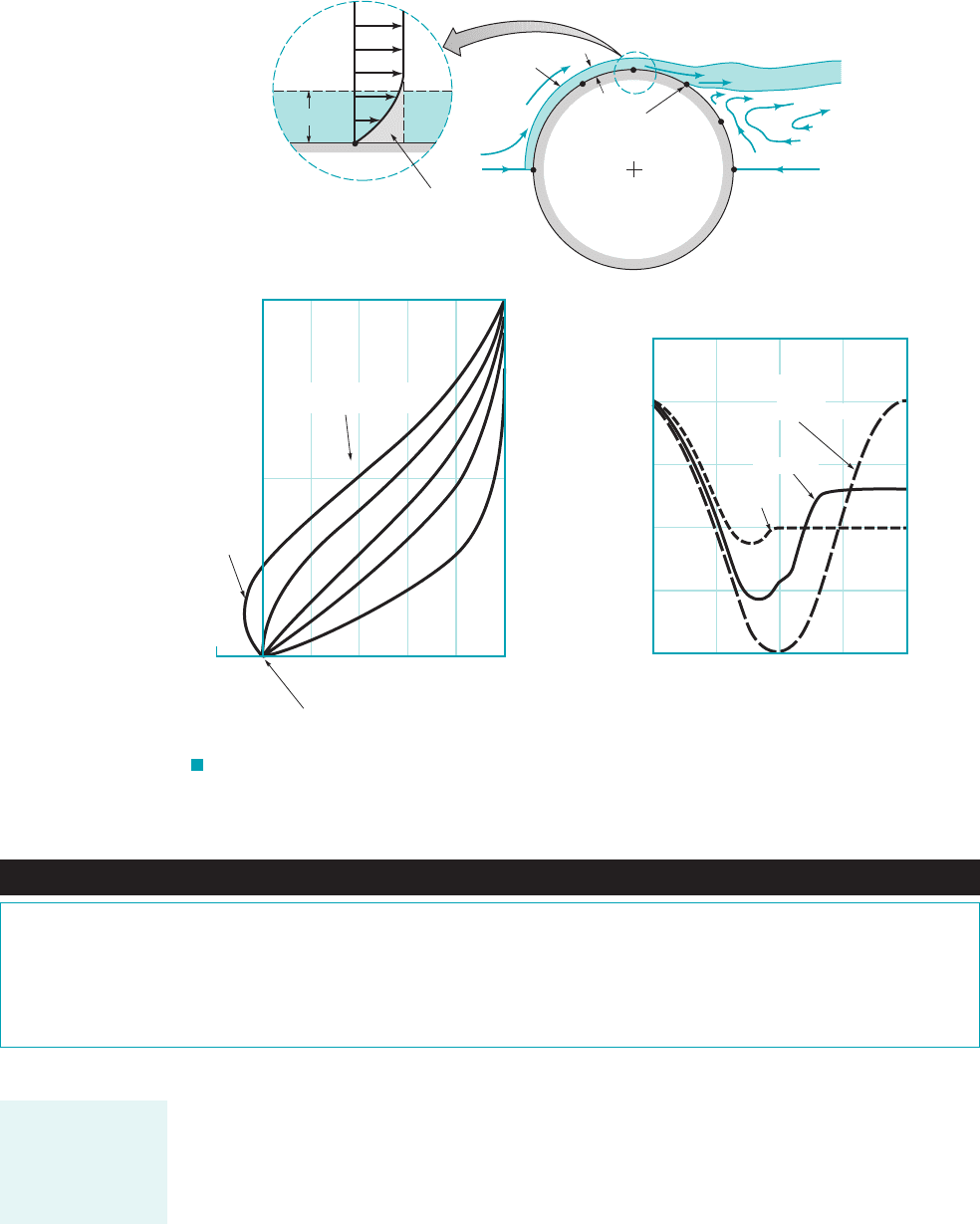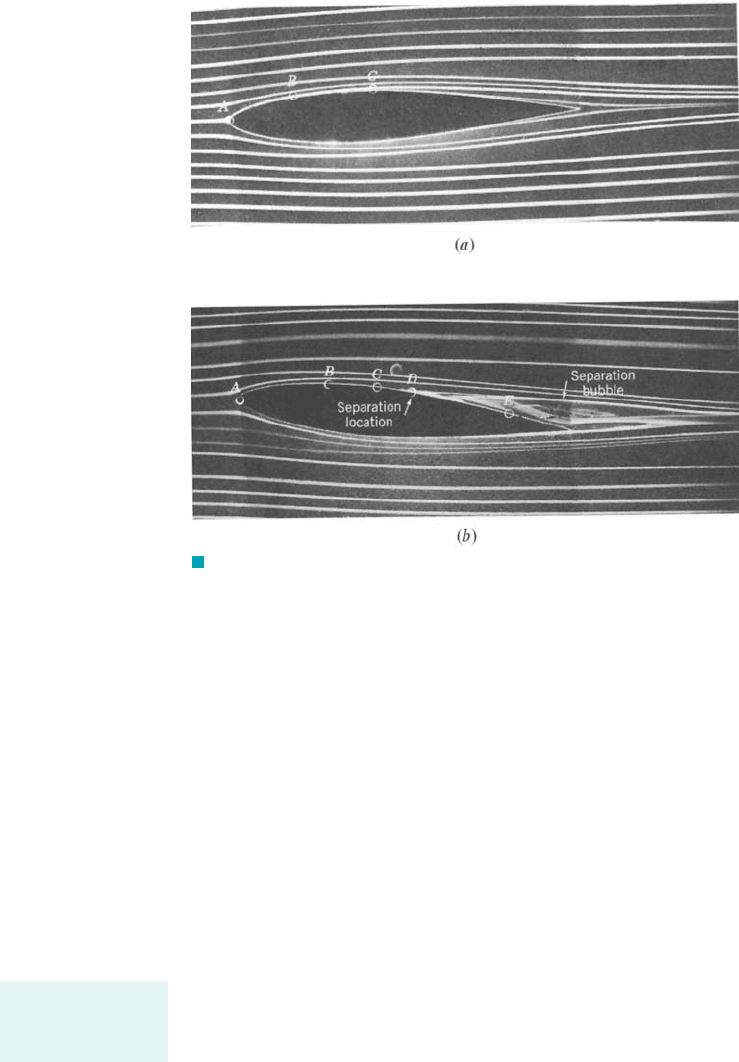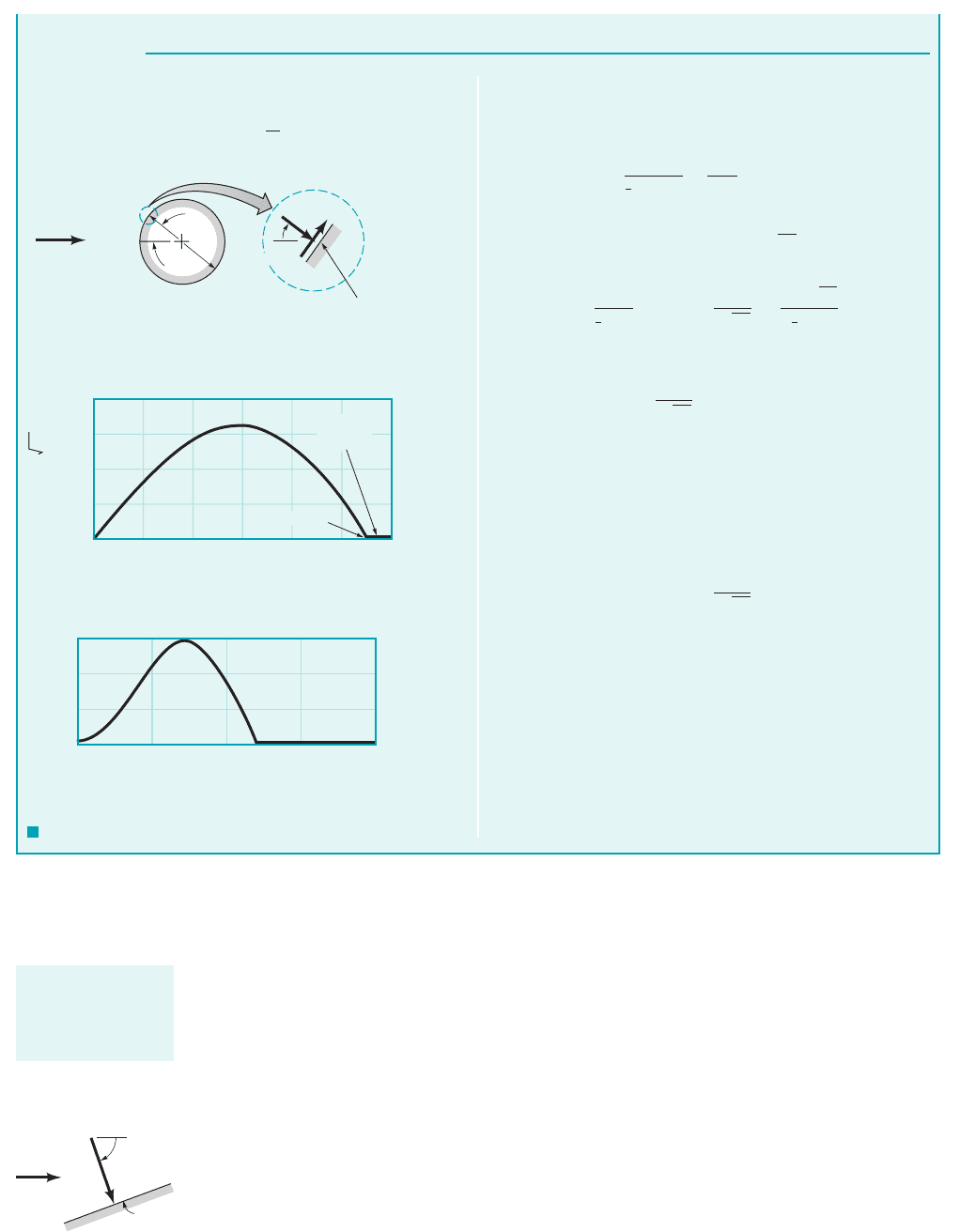Munson B.R. Fundamentals of Fluid Mechanics
Подождите немного. Документ загружается.


In general, the drag coefficient for a flat plate of length is a function of the Reynolds num-
ber, and the relative roughness, The results of numerous experiments covering a wide range
of the parameters of interest are shown in Fig. 9.15. For laminar boundary layer flow the drag co-
efficient is a function of only the Reynolds number—surface roughness is not important. This is
similar to laminar flow in a pipe. However, for turbulent flow, the surface roughness does affect the
shear stress and, hence, the drag coefficient. This is similar to turbulent pipe flow in which the sur-
face roughness may protrude into or through the viscous sublayer next to the wall and alter the flow
in this thin, but very important, layer 1see Section 8.4.12. Values of the roughness, for different
materials can be obtained from Table 8.1.
The drag coefficient diagram of Fig. 9.15 1boundary layer flow2shares many characteris-
tics in common with the familiar Moody diagram 1pipe flow2of Fig. 8.23, even though the mech-
anisms governing the flow are quite different. Fully developed horizontal pipe flow is governed
by a balance between pressure forces and viscous forces. The fluid inertia remains constant
throughout the flow. Boundary layer flow on a horizontal flat plate is governed by a balance be-
tween inertia effects and viscous forces. The pressure remains constant throughout the flow. 1As
is discussed in Section 9.2.6, for boundary layer flow on curved surfaces, the pressure is not
constant.2
It is often convenient to have an equation for the drag coefficient as a function of the Reynolds
number and relative roughness rather than the graphical representation given in Fig. 9.15. Although
there is not one equation valid for the entire range, the equations presented in Table 9.3
do work well for the conditions indicated.
Re
/
⫺ e
Ⲑ
/
e,
e
Ⲑ
/.Re
/
,
/
9.2 Boundary Layer Characteristics 487
0.002
0
0.004
0.006
0.008
0.010
0.012
10
5
10
6
10
7
10
8
10
9
Re
ᐉ
C
Df
Turbulent
Completely
turbulent
1 × 10
–3
2 × 10
–3
= 3 × 10
–3
5 × 10
–3
ε
Laminar
5 × 10
–4
2 × 10
–4
1 × 10
–4
5 × 10
–5
5 × 10
–6
1 × 10
–6
Transitional
Turbulent
smooth plate
2 × 10
–5
ᐉ
0.014
F I G U R E 9.15 Friction drag coefficient for a flat
plate parallel to the upstream flow (Ref. 18, with permission).
The flat plate drag
coefficient is a
function of relative
roughness and
Reynolds number.
TABLE 9.3
Empirical Equations for the Flat Plate Drag Coefficient (Ref. 1)
Equation Flow Conditions
Laminar flow
Transitional with
Turbulent, smooth plate
Completely turbulentC
Df
⫽ 31.89 ⫺ 1.62 log1e
Ⲑ
/24
⫺2.5
C
Df
⫽ 0.455
Ⲑ
1log Re
/
2
2.58
Re
xcr
⫽ 5 ⫻ 10
5
C
Df
⫽ 0.455
Ⲑ
1log Re
/
2
2.58
⫺ 1700
Ⲑ
Re
/
C
Df
⫽ 1.328
Ⲑ
1Re
/
2
0.5
JWCL068_ch09_461-533.qxd 9/23/08 11:47 AM Page 487

9.2.6 Effects of Pressure Gradient
The boundary layer discussions in the previous parts of Section 9.2 have dealt with flow along a
flat plate in which the pressure is constant throughout the fluid. In general, when a fluid flows past
an object other than a flat plate, the pressure field is not uniform. As shown in Fig. 9.6, if the
Reynolds number is large, relatively thin boundary layers will develop along the surfaces. Within
488 Chapter 9 ■ Flow over Immersed Bodies
GIVEN The water ski shown in Fig. E9.7a moves through
water with a velocity U.70 °F
FIND Estimate the drag caused by the shear stress on the bot-
tom of the ski for 0 6 U 6 30 ft
Ⲑ
s.
S
OLUTION
Drag on a Flat Plate
From Eq. 1 the corresponding drag is
By covering the range of upstream velocities of interest we obtain
the results shown in Fig. E9.7b.
(Ans)
COMMENTS If the results of boundary layer
theory are not valid—inertia effects are not dominant enough and
the boundary layer is not thin compared with the length of the
plate. For our problem this corresponds to
For all practical purposes U is greater than this value, and the flow
past the ski is of the boundary layer type.
The approximate location of the transition from laminar to tur-
bulent boundary layer flow as defined by
is indicated in Fig. E9.7b. Up to the entire
boundary layer is laminar. The fraction of the boundary layer that
is laminar decreases as U increases until only the front 0.18 ft is
laminar when
For anyone who has water skied, it is clear that it can require
considerably more force to be pulled along at than the
1two skis2indicated in Fig. E9.7b. As is
discussed in Section 9.3, the total drag on an object such as a wa-
ter ski consists of more than just the friction drag. Other compo-
nents, including pressure drag and wave-making drag, add con-
siderably to the total resistance.
2 ⫻ 4.88 lb ⫽ 9.76 lb
30 ft
Ⲑ
s
U ⫽ 30 ft
Ⲑ
s.
U ⫽ 1.31 ft
Ⲑ
s5 ⫻ 10
5
Re
cr
⫽ rUx
cr
Ⲑ
m ⫽
U ⫽ 2.63 ⫻ 10
⫺3
ft
Ⲑ
s.
Re f 1000,
d
f
⫽ 1.941102
2
10.003082⫽ 0.598 lb
0.00308.
E
XAMPLE 9.7
Clearly the ski is not a flat plate, and it is not aligned exactly
parallel to the upstream flow. However, we can obtain a reason-
able approximation to the shear force by using the flat plate re-
sults. That is, the friction drag, caused by the shear stress on
the bottom of the ski 1the wall shear stress2can be determined as
With and
1see Table B.12we obtain
(1)
where and U are in pounds and respectively.
The friction coefficient, can be obtained from Fig. 9.15 or
from the appropriate equations given in Table 9.3. As we will see,
for this problem, much of the flow lies within the transition
regime where both the laminar and turbulent portions of the
boundary layer flow occupy comparable lengths of the plate. We
choose to use the values of from the table.
For the given conditions we obtain
where U is in With or we
obtain from Table 9.3 C
Df
⫽ 0.455
Ⲑ
1log Re
/
2
2.58
⫺ 1700
Ⲑ
Re
/
⫽
Re
/
⫽ 3.80 ⫻ 10
6
,U ⫽ 10 ft
Ⲑ
s,ft
Ⲑ
s.
Re
/
⫽
rU/
m
⫽
11.94 slugs
Ⲑ
ft
3
214 ft2U
2.04 ⫻ 10
⫺5
lb
#
s
Ⲑ
ft
2
⫽ 3.80 ⫻ 10
5
U
C
Df
C
Df
,
ft
Ⲑ
s,d
f
⫽ 1.94 U
2
C
Df
d
f
⫽
1
2
11.94 slugs
Ⲑ
ft
3
212.0 ft
2
2U
2
C
Df
2.04 ⫻ 10
⫺5
lb
#
s
Ⲑ
ft
2
m ⫽A ⫽ /b ⫽ 4 ft ⫻ 0.5 ft ⫽ 2 ft
2
, r ⫽ 1.94 slugs
Ⲑ
ft
3
,
d
f
⫽
1
2
rU
2
/bC
Df
d
f
,
0
0
1
2
3
4
5
5 10 15 20 25 30
1
2
3
4
5
U, ft /s
Entire boundary
layer laminar
x
cr
Ᏸ
f
Ᏸ
f
, lb
x
cr
, ft
b = width = 0.5 ft
x = 0
x = 4 ft = ᐉ
U
x
(a)
(b)
F I G U R E E9.7
JWCL068_ch09_461-533.qxd 9/23/08 11:47 AM Page 488

these layers the component of the pressure gradient in the streamwise direction 1i.e., along the body
surface2is not zero, although the pressure gradient normal to the surface is negligibly small. That
is, if we were to measure the pressure while moving across the boundary layer from the body to
the boundary layer edge, we would find that the pressure is essentially constant. However, the pres-
sure does vary in the direction along the body surface if the body is curved, as shown by the fig-
ure in the margin. The variation in the free-stream velocity, the fluid velocity at the edge of
the boundary layer, is the cause of the pressure gradient in this direction. The characteristics of the
entire flow 1both within and outside of the boundary layer2are often highly dependent on the pres-
sure gradient effects on the fluid within the boundary layer.
For a flat plate parallel to the upstream flow, the upstream velocity 1that far ahead of the
plate2and the free-stream velocity 1that at the edge of the boundary layer2are equal—
This is a consequence of the negligible thickness of the plate. For bodies of nonzero thickness,
these two velocities are different. This can be seen in the flow past a circular cylinder of diame-
ter D. The upstream velocity and pressure are U and respectively. If the fluid were completely
inviscid the Reynolds number would be infinite and the stream-
lines would be symmetrical, as are shown in Fig. 9.16a. The fluid velocity along the surface would
vary from at the very front and rear of the cylinder 1points A and F are stagnation points2
to a maximum of at the top and bottom of the cylinder 1point C2. This is also indicated
in the figure in the margin. The pressure on the surface of the cylinder would be symmetrical
about the vertical midplane of the cylinder, reaching a maximum value of 1the stag-
nation pressure2at both the front and back of the cylinder, and a minimum of at the
top and bottom of the cylinder. The pressure and free-stream velocity distributions are shown in
Figs. 9.16b and 9.16c. These characteristics can be obtained from potential flow analysis of Sec-
tion 6.6.3.
Because of the absence of viscosity 1therefore, 2and the symmetry of the pressure
distribution for inviscid flow past a circular cylinder, it is clear that the drag on the cylinder is zero.
Although it is not obvious, it can be shown that the drag is zero for any object that does not produce
a lift 1symmetrical or not2in an inviscid fluid 1Ref. 42. Based on experimental evidence, however, we
know that there must be a net drag. Clearly, since there is no purely inviscid fluid, the reason for the
observed drag must lie on the shoulders of the viscous effects.
To test this hypothesis, we could conduct an experiment by measuring the drag on an object
1such as a circular cylinder2in a series of fluids with decreasing values of viscosity. To our initial
surprise we would find that no matter how small we make the viscosity 1provided it is not pre-
cisely zero2we would measure a finite drag, essentially independent of the value of As was
noted in Section 6.6.3, this leads to what has been termed d’Alembert’s paradox—the drag on an
m.
t
w
0
p
0
3rU
2
2
p
0
rU
2
2
U
fs
2U
U
fs
0
rUD
m 21Re 1m 02,
p
0
,
U U
fs
.
U
fs
,
9.2 Boundary Layer Characteristics 489
The free-stream ve-
locity on a curved
surface is not
constant.
U
fs
= 0
U
U
fs
= 2U
U
fs
= U
A
F
C
θ
p
0
+ U
2
1
2
p
0
– U
2
1
2
p
0
– U
2
p
0
– U
2
3
2
p
0
2U
U
0
0
90
180
, degrees
θ
0 90 180
, degrees
θ
U
fs
U, p
0
A
C
F
C
FA
U
fs
(a)
(
b)
(
c)
ρ
ρ
ρ
ρ
p
F I G U R E 9.16 Inviscid flow past a
circular cylinder: (a) streamlines for the flow if
there were no viscous effects, (b) pressure distribu-
tion on the cylinder’s surface, (c) free-stream veloc-
ity on the cylinder’s surface.
U
fs
1
U
fs
2
p
1
p
2
(1)
(2)
JWCL068_ch09_461-533.qxd 9/23/08 11:47 AM Page 489

object in an inviscid fluid is zero, but the drag on an object in a fluid with vanishingly small 1but
nonzero2viscosity is not zero.
The reason for the above paradox can be described in terms of the effect of the pressure
gradient on boundary layer flow. Consider large Reynolds number flow of a real 1viscous2fluid
past a circular cylinder. As was discussed in Section 9.1.2, we expect the viscous effects to be
confined to thin boundary layers near the surface. This allows the fluid to stick to the
surface—a necessary condition for any fluid, provided The basic idea of boundary layer
theory is that the boundary layer is thin enough so that it does not greatly disturb the flow out-
side the boundary layer. Based on this reasoning, for large Reynolds numbers the flow through-
out most of the flow field would be expected to be as is indicated in Fig. 9.16a, the inviscid
flow field.
The pressure distribution indicated in Fig. 9.16b is imposed on the boundary layer flow along
the surface of the cylinder. In fact, there is negligible pressure variation across the thin boundary
layer so that the pressure within the boundary layer is that given by the inviscid flow field. This
pressure distribution along the cylinder is such that the stationary fluid at the nose of the cylinder
is accelerated to its maximum velocity at and then is de-
celerated back to zero velocity at the rear of the cylinder at This is accom-
plished by a balance between pressure and inertia effects; viscous effects are absent for the invis-
cid flow outside the boundary layer.
Physically, in the absence of viscous effects, a fluid particle traveling from the front to
the back of the cylinder coasts down the “pressure hill” from to 1from point A
to C in Fig. 9.16b2and then back up the hill to 1from point C to F2without any loss
of energy. There is an exchange between kinetic and pressure energy, but there are no energy
losses. The same pressure distribution is imposed on the viscous fluid within the boundary layer.
The decrease in pressure in the direction of flow along the front half of the cylinder is termed
a favorable pressure gradient. The increase in pressure in the direction of flow along the rear
half of the cylinder is termed an adverse pressure gradient.
Consider a fluid particle within the boundary layer indicated in Fig. 9.17a. In its attempt
to flow from A to F it experiences the same pressure distribution as the particles in the free
stream immediately outside the boundary layer—the inviscid flow field pressure. However,
because of the viscous effects involved, the particle in the boundary layer experiences a loss
of energy as it flows along. This loss means that the particle does not have enough energy to
coast all of the way up the pressure hill 1from C to F2and to reach point F at the rear of the
cylinder. This kinetic energy deficit is seen in the velocity profile detail at point C, shown in
Fig. 9.17a. Because of friction, the boundary layer fluid cannot travel from the front to the
rear of the cylinder. 1This conclusion can also be obtained from the concept that due to vis-
cous effects the particle at C does not have enough momentum to allow it to coast up the pres-
sure hill to F.2
The situation is similar to a bicyclist coasting down a hill and up the other side of the val-
ley. If there were no friction, the rider starting with zero speed could reach the same height from
which he or she started. Clearly friction 1rolling resistance, aerodynamic drag, etc.2causes a loss
of energy 1and momentum2, making it impossible for the rider to reach the height from which he
or she started without supplying additional energy 1i.e., pedaling2. The fluid within the boundary
layer does not have such an energy supply. Thus, the fluid flows against the increasing pressure as
far as it can, at which point the boundary layer separates from 1lifts off2the surface. This bound-
ary layer separation is indicated in Fig. 9.17a as well as the figures in the margin. (See the pho-
tograph at the beginning of Chapters 7, 9, and 11.) Typical velocity profiles at representative lo-
cations along the surface are shown in Fig. 9.17b. At the separation location 1profile D2, the velocity
gradient at the wall and the wall shear stress are zero. Beyond that location 1from D to E2there is
reverse flow in the boundary layer.
As is indicated in Fig. 9.17c, because of the boundary layer separation, the average pressure
on the rear half of the cylinder is considerably less than that on the front half. Thus, a large pres-
sure drag is developed, even though 1because of small viscosity2the viscous shear drag may be
quite small. D’Alembert’s paradox is explained. No matter how small the viscosity, provided it is
not zero, there will be a boundary layer that separates from the surface, giving a drag that is, for
the most part, independent of the value of m.
u 180°
u 90°u 0
u 180°2.1U
fs
0
u 90°21U
fs
2U1U
fs
0 at u 02
m 0.
1V 02
490 Chapter 9 ■ Flow over Immersed Bodies
The pressure gradi-
ent in the external
flow is imposed
throughout the
boundary layer
fluid.
Separation
location
V9.6 Snow drifts
JWCL068_ch09_461-533.qxd 9/23/08 11:47 AM Page 490

The location of separation, the width of the wake region behind the object, and the pressure
distribution on the surface depend on the nature of the boundary layer flow. Compared with a lam-
inar boundary layer, a turbulent boundary layer flow has more kinetic energy and momentum as-
sociated with it because: 112as is indicated in Fig. E9.6, the velocity profile is fuller, more nearly
like the ideal uniform profile, and 122there can be considerable energy associated with the swirling,
random components of the velocity that do not appear in the time-averaged x component of veloc-
ity. Thus, as is indicated in Fig. 9.17c, the turbulent boundary layer can flow farther around the
cylinder 1farther up the pressure hill2before it separates than can the laminar boundary layer.
The structure of the flow field past a circular cylinder is completely different for a zero vis-
cosity fluid than it is for a viscous fluid, no matter how small the viscosity is, provided it is not
9.2 Boundary Layer Characteristics 491
F I G U R E 9.17 Boundary layer characteristics on a circular cylinder: (a) boundary
layer separation location, (b) typical boundary layer velocity profiles at various locations on the
cylinder, (c) surface pressure distributions for inviscid flow and boundary layer flow.
Boundary layer
fluid has kinetic
energy deficit
C
δ
Boundary
layer
A
B
C
D
E
F
Boundary layer
separation
location
δ
(a)
(
b)(c)
Locations indicated in
Figs. 9.17
a and 9.18
E
D
C
B
A
1.0
0.5
0–0.2 0.2 0.4 0.6 0.8 1.0
Separated
flow
y
__
δ
u
___
U
fs
For profile D, = 0 at y = 0
u
___
y
∂
∂
2.0
1.0
0.0
–1.0
–2.0
–3.0
0 45° 90° 135° 180°
Laminar
Turbulent
Inviscid
theory
C
p
= 1 – 4 sin
2
θ
C
p
=
p – p
0
_______
U
2
1
_
2
θ
ρ
Fluids in the News
Increasing truck mpg A large portion of the aerodynamic drag
on semis (tractor-trailer rigs) is a result of the low pressure on
the flat back end of the trailer. Researchers have recently devel-
oped a drag-reducing attachment that could reduce fuel costs on
these big rigs by 10 percent. The device consists of a set of flat
plates (attached to the rear of the trailer) that fold out into a box
shape, thereby making the originally flat rear of the trailer a
somewhat more “aerodynamic” shape. Based on thorough wind
tunnel testing and actual tests conducted with a prototype design
used in a series of cross-country runs, it is estimated that trucks
using the device could save approximately $6,000 a year in fuel
costs.
Viscous effects
within the bound-
ary layer cause
boundary layer
separation.
JWCL068_ch09_461-533.qxd 9/23/08 11:47 AM Page 491

zero. This is due to boundary layer separation. Similar concepts hold for other shaped bodies as
well. The flow past an airfoil at zero angle of attack 1the angle between the upstream flow and the
axis of the object2is shown in Fig. 9.18a; flow past the same airfoil at a angle of attack is shown
in Fig. 9.18b. Over the front portion of the airfoil the pressure decreases in the direction of flow—
a favorable pressure gradient. Over the rear portion the pressure increases in the direction of flow—
an adverse pressure gradient. The boundary layer velocity profiles at representative locations are
similar to those indicated in Fig. 9.17b for flow past a circular cylinder. If the adverse pressure
gradient is not too great 1because the body is not too “thick” in some sense2, the boundary layer
fluid can flow into the slightly increasing pressure region 1i.e., from C to the trailing edge in Fig.
9.18a2without separating from the surface. However, if the pressure gradient is too adverse 1because
the angle of attack is too large2, the boundary layer will separate from the surface as indicated in
Fig. 9.18b. Such situations can lead to the catastrophic loss of lift called stall, which is discussed
in Section 9.4.
Streamlined bodies are generally those designed to eliminate 1or at least to reduce2the ef-
fects of separation, whereas nonstreamlined bodies generally have relatively large drag due to the
low pressure in the separated regions 1the wake2. Although the boundary layer may be quite thin,
it can appreciably alter the entire flow field because of boundary layer separation. These ideas are
discussed in Section 9.3.
9.2.7 Momentum Integral Boundary Layer Equation with Nonzero
Pressure Gradient
The boundary layer results discussed in Sections 9.2.2 and 9.2.3 are valid only for boundary lay-
ers with zero pressure gradients. They correspond to the velocity profile labeled C in Fig. 9.17b.
Boundary layer characteristics for flows with nonzero pressure gradients can be obtained from
nonlinear, partial differential boundary layer equations similar to Eqs. 9.8 and 9.9, provided the
pressure gradient is appropriately accounted for. Such an approach is beyond the scope of this
book 1Refs. 1, 22.
5°
492 Chapter 9 ■ Flow over Immersed Bodies
F I G U R E 9.18 Flow visualization photographs of flow past an airfoil (the boundary layer
velocity profiles for the points indicated are similar to those indicated in Fig. 9.17b): (a) zero angle of attack,
no separation, (b) angle of attack, flow separation. Dye in water. (Photograph courtesy of ONERA, France.)5ⴗ
Streamlined bodies
generally have no
separated flow.
JWCL068_ch09_461-533.qxd 9/23/08 11:47 AM Page 492

An alternative approach is to extend the momentum integral boundary layer equation technique
1Section 9.2.32so that it is applicable for flows with nonzero pressure gradients. The momentum in-
tegral equation for boundary layer flows with zero pressure gradient, Eq. 9.26, is a statement of the
balance between the shear force on the plate 1represented by 2and rate of change of momentum of
the fluid within the boundary layer [represented by ]. For such flows the free-stream ve-
locity is constant If the free-stream velocity is not constant [ where x is the
distance measured along the curved body], the pressure will not be constant. This follows from the
Bernoulli equation with negligible gravitational effects, since is constant along the stream-
lines outside the boundary layer. Thus,
(9.34)
For a given body the free-stream velocity and the corresponding pressure gradient on the surface
can be obtained from inviscid flow techniques 1potential flow2discussed in Section 6.7. 1This is
how the circular cylinder results of Fig. 9.16 were obtained.2
Flow in a boundary layer with nonzero pressure gradient is very similar to that shown in Fig.
9.11, except that the upstream velocity, U, is replaced by the free-stream velocity, and the
pressures at sections 112and 122are not necessarily equal. By using the x component of the mo-
mentum equation 1Eq. 5.222with the appropriate shear forces and pressure forces acting on the
control surface indicated in Fig. 9.11, the following integral momentum equation for boundary
layer flows is obtained:
(9.35)
The derivation of this equation is similar to that of the corresponding equation for constant-pressure
boundary layer flow, Eq. 9.26, although the inclusion of the pressure gradient effect brings in ad-
ditional terms 1Refs. 1, 2, 32. For example, both the boundary layer momentum thickness, and
the displacement thickness, are involved.
Equation 9.35, the general momentum integral equation for two-dimensional boundary layer
flow, represents a balance between viscous forces 1represented by 2, pressure forces 1represented
by 2, and the fluid momentum 1represented by the boundary layer mo-
mentum thickness2. In the special case of a flat plate, constant, and Eq. 9.35 reduces
to Eq. 9.26.
Equation 9.35 can be used to obtain boundary layer information in a manner similar to that
done for the flat plate boundary layer 1Section 9.2.32. That is, for a given body shape the free-
stream velocity, is determined, and a family of approximate boundary layer profiles is assumed.
Equation 9.35 is then used to provide information about the boundary layer thickness, wall shear
stress, and other properties of interest. The details of this technique are not within the scope of this
book 1Refs. 1, 32.
U
fs
,
U
fs
⫽ U ⫽
™,rU
fs
dU
fs
Ⲑ
dx ⫽⫺dp
Ⲑ
dx
t
w
d*,
™,
t
w
⫽ r
d
dx
1U
2
fs
™2⫹ rd* U
fs
dU
fs
dx
U
fs
1x2,
dp
dx
⫽⫺rU
fs
dU
fs
dx
p ⫹ rU
2
fs
Ⲑ
2
U
fs
⫽ U
fs
1x2,1U
fs
⫽ U2.
rU
2
1d™
Ⲑ
dx2
t
w
9.3 Drag 493
9.3 Drag
As was discussed in Section 9.1, any object moving through a fluid will experience a drag, —a net
force in the direction of flow due to the pressure and shear forces on the surface of the object. This net
force, a combination of flow direction components of the normal and tangential forces on the body,
can be determined by use of Eqs. 9.1 and 9.2, provided the distributions of pressure, p, and wall shear
stress, are known. Only in very rare instances can these distributions be determined analytically.
The boundary layer flow past a flat plate parallel to the upstream flow as is discussed in Section 9.2
is one such case. Current advances in computational fluid dynamics, CFD, 1i.e., the use of computers
to solve the governing equations of the flow field2have provided encouraging results for more com-
plex shapes. However, much work in this area remains.
Most of the information pertaining to drag on objects is a result of numerous experiments with
wind tunnels, water tunnels, towing tanks, and other ingenious devices that are used to measure the
drag on scale models. As was discussed in Chapter 7, these data can be put into dimensionless form
t
w
,
d
Pressure gradient
effects can be in-
cluded in the mo-
mentum integral
equation.
JWCL068_ch09_461-533.qxd 9/23/08 11:48 AM Page 493

and the results can be appropriately ratioed for prototype calculations. Typically, the result for a
given-shaped object is a drag coefficient, where
(9.36)
and is a function of other dimensionless parameters such as Reynolds number, Re, Mach num-
ber, Ma, Froude number, Fr, and relative roughness of the surface, That is,
The character of as a function of these parameters is discussed in this section.
9.3.1 Friction Drag
Friction drag, is that part of the drag that is due directly to the shear stress, on the object.
It is a function of not only the magnitude of the wall shear stress, but also of the orientation of the
surface on which it acts. This is indicated by the factor in Eq. 9.1. If the surface is parallel
to the upstream velocity, the entire shear force contributes directly to the drag. This is true for the
flat plate parallel to the flow as was discussed in Section 9.2. If the surface is perpendicular to the
upstream velocity, the shear stress contributes nothing to the drag. Such is the case for a flat plate
normal to the upstream velocity as was discussed in Section 9.1.
In general, the surface of a body will contain portions parallel to and normal to the upstream
flow, as well as any direction in between. A circular cylinder is such a body. Because the viscos-
ity of most common fluids is small, the contribution of the shear force to the overall drag on a
body is often quite small. Such a statement should be worded in dimensionless terms. That is, be-
cause the Reynolds number of most familiar flows is quite large, the percent of the drag caused
directly by the shear stress is often quite small. For highly streamlined bodies or for low Reynolds
number flow, however, most of the drag may be due to friction drag.
The friction drag on a flat plate of width b and length oriented parallel to the upstream
flow can be calculated from
where is the friction drag coefficient. The value of given as a function of Reynolds num-
ber, and relative surface roughness, in Fig. 9.15 and Table 9.3, is a result of
boundary layer analysis and experiments 1see Section 9.22. Typical values of roughness, for var-
ious surfaces are given in Table 8.1. As with the pipe flow discussed in Chapter 8, the flow is di-
vided into two distinct categories—laminar or turbulent, with a transitional regime connecting
them. The drag coefficient 1and, hence, the drag2is not a function of the plate roughness if the
flow is laminar. However, for turbulent flow the roughness does considerably affect the value of
As with pipe flow, this dependence is a result of the surface roughness elements protruding
into or through the laminar sublayer 1see Section 8.32.
Most objects are not flat plates parallel to the flow; instead, they are curved surfaces along
which the pressure varies. As was discussed in Section 9.2.6, this means that the boundary layer char-
acter, including the velocity gradient at the wall, is different for most objects from that for a flat plate.
This can be seen in the change of shape of the boundary layer profile along the cylinder in Fig. 9.17b.
The precise determination of the shear stress along the surface of a curved body is quite
difficult to obtain. Although approximate results can be obtained by a variety of techniques 1Refs.
1, 22, these are outside the scope of this text. As is shown by the following example, if the shear
stress is known, its contribution to the drag can be determined.
C
Df
.
e,
e
Ⲑ
/,Re
/
⫽ rU/
Ⲑ
m,
C
Df
,C
Df
d
f
⫽
1
2
rU
2
b/C
Df
/
t
w
sin u
t
w
,d
f
,
C
D
C
D
⫽ f1shape, Re, Ma, Fr, e
Ⲑ
/2
e
Ⲑ
/.
C
D
C
D
⫽
d
1
2
rU
2
A
C
D
,
494 Chapter 9 ■ Flow over Immersed Bodies
Friction (viscous)
drag is the drag
produced by viscous
shear stresses.
GIVEN A viscous, incompressible fluid flows past the circu-
lar cylinder shown in Fig. E9.8a. According to a more advanced
theory of boundary layer flow, the boundary layer remains
attached to the cylinder up to the separation location at
with the dimensionless wall shear stress as is indi-u ⬇ 108.8°,
Drag Coefficient Based on Friction Drag
E
XAMPLE 9.8
cated in Fig. E9.8b 1Ref. 12. The shear stress on the cylinder in
the wake region, is negligible.
FIND Determine the drag coefficient for the cylinder
based on the friction drag only.
C
Df
,
108.8 6 u 6 180°,
JWCL068_ch09_461-533.qxd 9/23/08 11:48 AM Page 494

9.3.2 Pressure Drag
Pressure drag, is that part of the drag that is due directly to the pressure, p, on an object.
It is often referred to as form drag because of its strong dependency on the shape or form of the
object. Pressure drag is a function of the magnitude of the pressure and the orientation of the
surface element on which the pressure force acts. For example, the pressure force on either side
of a flat plate parallel to the flow may be very large, but it does not contribute to the drag be-
cause it acts in the direction normal to the upstream velocity. On the other hand, the pressure
force on a flat plate normal to the flow provides the entire drag.
As previously noted, for most bodies, there are portions of the surface that are parallel to the
upstream velocity, others normal to the upstream velocity, and the majority of which are at some
angle in between, as shown by the figure in the margin. The pressure drag can be obtained from
Eq. 9.1 provided a detailed description of the pressure distribution and the body shape is given.
That is,
d
p
⫽
p cos u dA
d
p
,
9.3 Drag 495
S
OLUTION
where b is the length of the cylinder. Note that is in radians 1not
degrees2to ensure the proper dimensions of
Thus,
This can be put into dimensionless form by using the dimension-
less shear stress parameter, given in
Fig. E9.8b as follows:
where Thus,
(1)
The function obtained from Fig. E9.8b, is plotted in
Fig. E9.8c. The necessary integration to obtain from Eq. 1 can
be done by an appropriate numerical technique or by an approxi-
mate graphical method to determine the area under the given
curve.
The result is or
(Ans)
COMMENTS Note that the total drag must include both the
shear stress 1friction2drag and the pressure drag. As we will see in
Example 9.9, for the circular cylinder most of the drag is due to
the pressure force.
The above friction drag result is valid only if the boundary layer
flow on the cylinder is laminar. As is discussed in Section 9.3.3, for
a smooth cylinder this means that It is
also valid only for flows that have a Reynolds number sufficiently
large to ensure the boundary layer structure to the flow. For the
cylinder, this means Re 7 100.
Re ⫽ rUD
Ⲑ
m 6 3 ⫻ 10
5
.
C
Df
⫽
5.93
1Re
p
0
F1u2 sin u du ⫽ 5.93,
C
Df
F1u2 sin u,
C
Df
⫽
1
1Re
p
0
F1u2 sin u du
Re ⫽ rUD
Ⲑ
m.
C
Df
⫽
p
0
t
w
1
2
rU
2
sin u du ⫽
1
1Re
p
0
t
w
1Re
1
2
rU
2
sin u du
F1u2⫽ t
w
1Re
Ⲑ
1rU
2
Ⲑ
22,
C
Df
⫽
d
f
1
2
rU
2
bD
⫽
2
rU
2
p
0
t
w
sin u du
2 1D
Ⲑ
22 b du.dA ⫽
u
The friction drag, can be determined from Eq. 9.1 as
d
f
⫽
t
w
sin u dA ⫽ 2 a
D
2
b b
p
0
t
w
sin u du
d
f
,
F I G U R E E9.8
U
θ
θ
θ
Re =
UD
_____
ρ
μ
(a)
(
b)
D
dA = b
D
d
__
2
p dA
w
dA
τ
, degrees
θ
Separation
θ
F = 0 for
> 108
120100806040200
0
2
4
8
6
w
Re
τ
1
_
2
U
2
ρ
F( ) ≡
_______
θ
ππ
3___
4
π
__
2
π
__
4
0
0
2
4
6
, rad
θ
θθ
(
c
)
F
( ) sin
Pressure (form)
drag is the drag
produced by normal
stresses.
pdA
dA
θ
U
JWCL068_ch09_461-533.qxd 9/23/08 11:48 AM Page 495

which can be rewritten in terms of the pressure drag coefficient, as
(9.37)
Here is the pressure coefficient, where is a reference pressure. The level
of the reference pressure does not influence the drag directly because the net pressure force on a
body is zero if the pressure is constant 1i.e., 2on the entire surface.
For flows in which inertial effects are large relative to viscous effects 1i.e., large Reynolds
number flows2, the pressure difference, scales directly with the dynamic pressure,
and the pressure coefficient is independent of Reynolds number. In such situations we expect the
drag coefficient to be relatively independent of Reynolds number.
For flows in which viscous effects are large relative to inertial effects 1i.e., very small Reynolds
number flows2, it is found that both the pressure difference and wall shear stress scale with the
characteristic viscous stress, where is a characteristic length. In such situations we expect
the drag coefficient to be proportional to That is,
These characteristics are similar to the friction factor dependence of for
laminar pipe flow and constant for large Reynolds number flow 1see Section 8.42.
If the viscosity were zero, the pressure drag on any shaped object 1symmetrical or not2in a
steady flow would be zero. There perhaps would be large pressure forces on the front portion of
the object, but there would be equally large 1and oppositely directed2pressure forces on the rear
portion. If the viscosity is not zero, the net pressure drag may be nonzero because of boundary
layer separation as is discussed in Section 9.2.6. Example 9.9 illustrates this.
f ⬃
f ⬃ 1
Rem
rU/ 1
Re.
C
D
⬃ d
1rU
2
22⬃ 1mU
/2
1rU
2
22 ⬃1
Re.
/mU
/,
rU
2
2,p p
0
,
p
0
p
0
C
p
1p p
0
2
1rU
2
22
C
Dp
d
p
1
2
rU
2
A
冮
p cos u dA
1
2
rU
2
A
冮
C
p
cos u dA
A
C
Dp
,
496 Chapter 9 ■ Flow over Immersed Bodies
The pressure coeffi-
cient is a dimen-
sionless form of the
pressure.
GIVEN A viscous, incompressible fluid flows past the circular
cylinder shown in Fig. E9.8a. The pressure coefficient on the
surface of the cylinder 1as determined from experimental measure-
ments2is as indicated in Fig. E9.9a.
S
OLUTION
Drag Coefficient Based on Pressure Drag
cylinder reduces the drag by pulling on the cylin-
der in the upstream direction. The positive area under the
curve is greater than the negative area—there is a net pressure drag.
In the absence of viscosity, these two contributions would be
equal—there would be no pressure 1or friction2drag.
The net drag on the cylinder is the sum of friction and pressure
drag. Thus, from Eq. 1 of Example 9.8 and Eq. 1 of this example,
we obtain the drag coefficient
(2)
(Ans)
This result is compared with the standard experimental value 1ob-
tained from Fig. 9.212in Fig. E9.9c. The agreement is very good
over a wide range of Reynolds numbers. For the curves
diverge because the flow is not a boundary layer type flow—the
shear stress and pressure distributions used to obtain Eq. 2 are not
valid in this range. The drastic divergence in the curves for
is due to the change from a laminar to turbulent
boundary layer, with the corresponding change in the pressure
distribution. This is discussed in Section 9.3.3.
Re 7 3 10
5
Re 6 10
C
D
C
Df
C
Dp
5.93
1Re
1.17
C
p
cos u
130 6 u 6 90°2
E
XAMPLE 9.9
The pressure 1form2drag coefficient, can be determined from
Eq. 9.37 as
or because of symmetry
where b and D are the length and diameter of the cylinder. To ob-
tain we must integrate the function from
radians. Again, this can be done by some numer-
ical integration scheme or by determining the area under the
curve shown in Fig. E9.9b. The result is
(1)
(Ans)
Note that the positive pressure on the front portion of the cylinder
and the negative pressure 1less than the upstream
value2on the rear portion produce positive contri-
butions to the drag. The negative pressure on the front portion of the
190 u 180°2
10 u 30°2
C
Dp
1.17
u 0 to u p
C
p
cos uC
Dp
,
C
Dp
冮
p
0
C
p
cos u du
C
Dp
1
A
冮
C
p
cos u dA
1
bD
冮
2p
0
C
p
cos u b a
D
2
b du
C
Dp
,
FIND Determine the pressure drag coefficient for this flow.
Combine the results of Examples 9.8 and 9.9 to determine the drag
coefficient for a circular cylinder. Compare your results with those
given in Fig. 9.21.
JWCL068_ch09_461-533.qxd 9/23/08 11:48 AM Page 496
